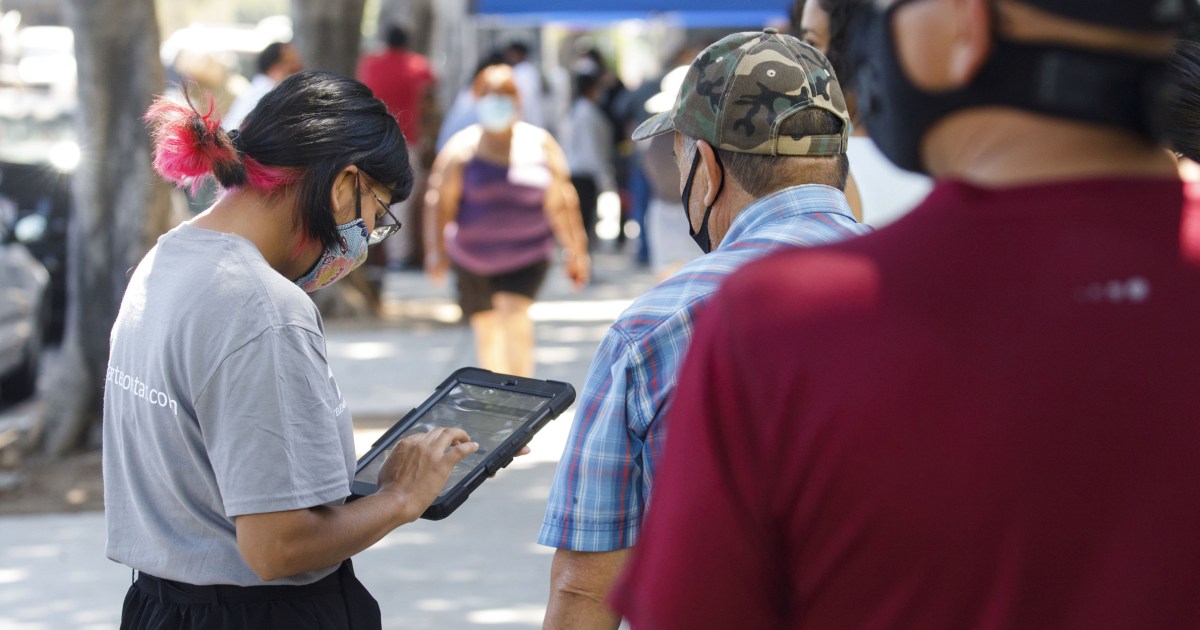By Jane C. Timm, Char Adams and Suzanne Gamboa - NBC News
The Census Bureau will release the census data states need to draw new voting maps on Thursday, kicking off what voting activists fear will be the most hectic and controversial redistricting cycle to date.
Detailed results of the local population census are months late due to the COVID-19 pandemic, meaning the complex and sometimes secretive process of determining congressional district boundaries will happen quickly.
[Senate Democrats pass a $ 3.5 billion budget that opens the door for health, education and tax reforms]
It is a company that takes place once every decade and coincides with the decennial census, a population count that decides everything, from representation in Congress to the distribution of federal aid.
Redistricting has the power to shape elections for years.
But in this cycle, the stakes are higher than ever, according to voting experts and activists.
New maps drawn by state Republicans could wipe out the slim majority of Democrats in the House of Representatives, neglecting the results of the 2022 midterm elections, experts say.
It is also the first time the redistricting process has occurred since the Supreme Court removed key federal protections against discriminatory maps in 2013 while giving the green light to
partisan
gerrymandering
in 2019, leaving activists fearful that the boundaries could significantly dilute the political power of people of color, even as minorities are driving the country's population growth.
Voters line up to cast their ballots for the Senate second-round election in Atlanta, Georgia on Tuesday, Jan. 5, 2021 Dustin Chambers / Bloomberg via Getty Images
"From the point of view of voters of color in the south, a train is heading down the tracks and we've been able to see it coming for a long time. The reality is that in places in the south you can't make a
partisan
gerrymander
without targeting voters. colored, "said Michael Li, a redistricting expert and senior counsel at the Brennan Center for Justice at New York University School of Law.
"Due to residential segregation, it is easier to separate or group communities of color to move the dial," he added.
What is
gerrymandering
?
The
gerrymandering
, a term describing handling in the delimitation of electoral maps of the country, is as old as American politics.
But technology and data have made it possible for lawmakers to draw maps of districts with increasing precision.
Experts and critics argue that letting legislators draw district boundaries allows them to elect their own voters, while
gerrymandering people
tend to argue that voters chose them and gave them the power to do what they see fit. timely.
[How the infrastructure plan could be key for Democrats to maintain a majority in the House of Representatives]
And while both parties have historically been guilty of this manipulation, Republicans invested heavily in campaigns for state legislatures before the last cycle and won the votes that helped them secure control of the process.
"Whoever controls redistricting can control Congress,"
wrote Republican strategist Karl Rove in spring 2010, describing the process in an opinion piece for The Wall Street Journal.
The maps the Republicans drew the following year gave the Republican Party a significant advantage over the past decade.
An analysis by the news agency The Associated Press revealed that in the 2016 election, Republicans won up to 22 additional seats in the House of Representatives above what would have been expected based on the average percentage of votes in the congressional districts of the whole country.
In this year's redistricting cycle, Republicans will once again control much of the process.
Republican lawmakers are charged with drawing 187 Lower House districts compared to Democratic lawmakers, who control the layout of 75 districts, according to an analysis by Kyle Kondik of the University of Virginia Center for Politics.
It is not yet clear which undocumented immigrants could be legalized through the budget promoted by Democrats
Aug. 11, 202101: 51
The other 173 boundaries are drawn by states with divided control, independent commissions, or no map is made because they are states of a single district.
That's partly because voters in some states have turned over control of their redistricting processes to commissions, arguing that voters or appointed commissioners can draw better district lines than politicians who have a vested interest in drawing. maps that help them maintain power.
[Texas Issues Arrest Warrants Against Democrats Who Absent to Block Voting Restricting Voting Rights]
In another opinion piece for The Wall Street Journal this year, Rove argued that Democrats were pushing themselves into mapping even when they denounced
gerrymandering
.
"The truth is that both sides use redistricting to improve their position. However, only one pretends to be holier than you in the process," he explained.
What is the census data expected to show and what's next in the process?
The data will show, as precisely as possible, where people live, detailing the ethnic, racial and voting age composition of neighborhoods.
They are expected to reveal that the nation is rapidly diversifying, while the proportion of white voters is shrinking.
The data will be given to mapmakers, state legislatures, independent commissions, who then set out to create equal-sized Lower House districts so that the 435 members represent roughly the same number of voters.
[Political and judicial battle in Florida and Texas so that children can wear a mask despite the prohibitions of the governors]
In April, the Census Bureau released state population totals that determine the number of House seats for each state, with just seven seats moving across 13 states, the smallest change since the current distribution model was adopted. Congress in the 1940s.
Texas was the biggest winner, getting two seats in the House of Representatives.
Colorado, Montana, Oregon, Florida and North Carolina each won one seat.
Losses were concentrated in the industrial Midwest, where Illinois, Michigan, Pennsylvania, West Virginia and Ohio lost a seat.
The Democratic strongholds of California and New York also lost a seat.
The dataset released Thursday is expected to reinforce a known trend - that
Hispanics have driven the nation's growth over the past decade
.
They are the largest racial and ethnic minority in the country, but that has not automatically translated into more political power, in part due to manipulation.
And activists fear that maintaining the trend could continue to dilute the political power of Latinos.
Latino lawmakers have expressed fear that results released Thursday indicate that the census has significantly underestimated the Latino population, as it has in recent years.
Former President Donald Trump's failed attempts to include a citizenship question in the census and exclude people without legal permission to be in the United States from the results made some fearful of completing the survey, according to NBC News, Noticias Telemundo's sister network. .
[A judge blocks the Texas governor's order to limit the transportation of immigrants released by the Border Patrol]
Activists from communities of color say they will try to mobilize their voters to get involved in the process, urging fair boundaries and preparing to lobby against what they see as unfair maps.
Although the labor market shows signs of recovery, Latinos are still the most unemployed
Aug. 6, 202100: 51
Fenika Miller, an activist from Houston County, Georgia who works with Black Voters Matter, a nonprofit activism group, noted that the 2011 redistricting helped damage her community by dividing black communities into multiple districts.
"It is difficult to say that the black population has been represented fairly here. It is difficult for people to believe that we can have a more progressive, fair and diverse representation," he said.
"We have to educate people to help them understand how the loss of power negatively affects our communities and quality of life," he said.
What is different about this cycle?
The loss of Section 5 of the Voting Rights Act, which the Supreme Court struck down in 2013, is likely to lead to the most significant change this year from previous redistricting cycles, according to activists and experts.
The provision required states to demonstrate to the Justice Department that their district maps would not discriminate against voters of color.
"There is nothing to stop states from being really aggressive and challenging a court," said Li of the Brennan Center for Justice.
"Before you knew there was a cop on the street, so you changed your behavior a bit. Now, without a cop on the block, you can put pressure on old women, you can target communities of color, you can do whatever you want, and maybe the police arrive after someone calls them, but they may not, "he explained.
[The future governor of New York says she will not allow a "toxic environment" in her Administration]
The ruling is one of the main reasons that voting rights activists have pushed for federal election legislation that seeks to ban
partisan
gerrymandering
.
The proposal is stalled in the Senate.
Also, according to activists, a more recent Supreme Court ruling saying federal courts could not consider
partisan
gerrymander
claims
offered Republicans an easy defense against those who might argue that a map is discriminatory. There is a strong overlap between race and partisanship.
Jon Greenbaum, lead attorney and senior deputy chairman of the Lawyers Committee for Civil Rights Under the Law, a nonprofit activist group, said
partisan
gerrymandering
was of particular concern to him in Georgia, where black voters were key to the victory of President Joe Biden last year and the results of the second round of the Senate in January that led to control of the Upper House for Democrats. Republicans control all three branches of state government, along with the redistricting process.
Greenbaum, one of the authors of a recent Lawyers Committee report outlining the risks of partisan manipulation in the state, noted that Georgia's voter registration form asks voters to list their race, not their party.
"I'm sure they are going to listen to map artists in Georgia: partisanship, partisanship, partisanship, partisanship. They will avoid using the word 'race' as much as they can," he said.









